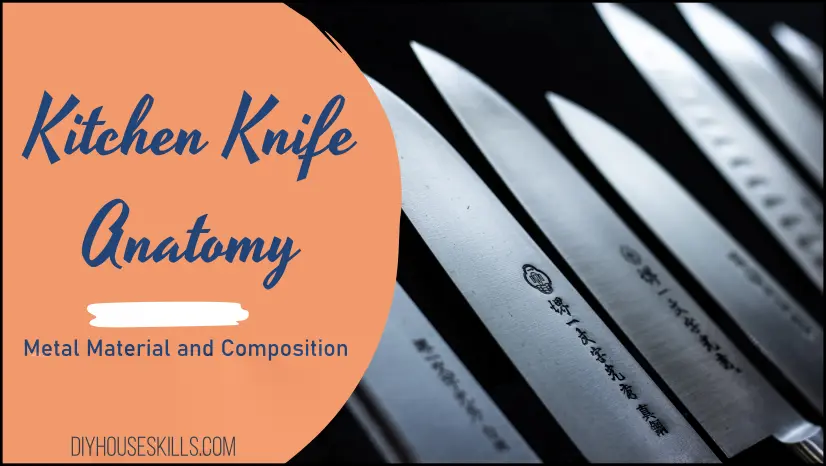Kitchen knives come in all shapes and sizes, but what are they made of?
- Understanding the differences between them is key to selecting the right knife for your needs.
- We’ll also provide tips on how to choose the right knife based on your specific culinary needs. Join us as we uncover all you need to know about kitchen knife material and composition.
In this blog post, we will explore the various metals used in kitchen knives, as well as how they differ in terms of composition, maintenance, and performance.
Want to make sure your kitchen knives last a lifetime? Then you’ll want to check out my article titled – Kitchen Knife Care: Do’s and Don’ts of Maintaining Knives. In it, I cover all details of taking proper care of your kitchen knives, including best practices for storage and sharpening, as well as tips on selecting quality cutting boards.
- Kitchen Knife Materials: A Beginner’s Guide
- What are the Best Materials for Quality Knives?
- Components of the Perfect Kitchen Knife
- Forged vs. stamped knives
- Comparing Stainless Steel and Carbon Steel Kitchen Knives: What You Need to Know.
- How much should you spend on a knife set?
- Which kitchen knife is right for you?
- The anatomy of a kitchen knife – Summary
THIS PAGE CONTAINS AFFILIATE LINKS. As an Amazon Associate, I earn from qualifying purchases. PLEASE READ MY DISCLOSURE FOR MORE INFO.
Kitchen Knife Materials: A Beginner’s Guide
When it comes to buying a new set of kitchen knives, one of the most important questions you must answer is which material is best for your needs.
What is the difference between kitchen knives that are made of stainless steel and those that are made of carbon steel? What about ceramic?
Fortunately, there are a wide variety of materials out there for kitchen knives, each with its own unique benefits and drawbacks.
Sharp and shining blades that cut with ease, A variety of kitchen knives to fulfill your needs. Stainless steel, carbon steel, and ceramic too, Each has unique benefits to help you cook like a pro.
1. Stainless steel knives:
Stainless steel kitchen knives are a great choice for those looking for a durable and corrosion-resistant blade. The combination of metals, including chromium, nickel, and molybdenum gives them additional strength, making them capable of withstanding wear and tear over time.
Additionally, regular care and maintenance will help extend the lifespan of these blades even further. Stainless steel knives are great for those who want an easy-to-maintain, long-lasting knife that can be used daily without showing signs of damage.
Does stainless steel make a good kitchen knife?
Yes, it makes an excellent knife because stainless steel kitchen knives are strong and can withstand a lot of wear and tear. Even after a lot of use, stainless steel kitchen knives can still be honed to get back their sharp edges.
In addition, they are easy to clean and do not rust easily.
- Resistant to rust.
- Durable and easy to sharpen.
- Easy to clean and store.
A stainless steel kitchen knife is the most common choice among homeowners who are not professional chefs.
What’s wrong with stainless steel knives?
The only downside to stainless steel kitchen knives is that they are not as hard as carbon steel and have less wear resistance. And thus, they require more frequent sharpening, which can be a bit of a hassle if you are a busy cook.
Tips for Stainless steel knives:
Here are some tips for getting the most out of your stainless steel kitchen knives:
- Always store your knives in a block or a knife drawer to protect their sharp edges from accidental damage.
- After use, wash and dry your blades thoroughly and immediately, as allowing them to remain wet can cause rusting.
- Regular honing is essential for maintaining a razor-sharp edge and creating even slices with every cut.
2. Carbon steel knives:
Carbon steel kitchen knives are also made of a combination of metals, but the main component is carbon. This type of steel is known for its sharpness and edge retention. However, carbon steel kitchen knives are more prone to rusting than stainless steel kitchen knives.
Does carbon steel make a good kitchen knife?
Yes, carbon steel knives are sharp and can hold an edge longer than stainless steel kitchen knives, but they are more prone to rusting.
- Vulnerable to rust.
- Not as durable as stainless.
- Retains sharpness and edge well.
A quality carbon steel knife is more often preferred among professional chefs.
What’s wrong with carbon steel knives?
The downside to carbon steel kitchen knives is that they are not as durable as stainless steel kitchen knives and can rust if not taken care of properly. Steel made with higher carbon content is harder but also more brittle.
More care is required for high-carbon steel. Before putting it away, oil to prevent rust and use a stone to sharpen it.
3. Laminate knives:
Laminate knives are an often overlooked alternative to stainless steel and carbon steel blades. Laminate blades are manufactured by fusing layers of steel together with a harder outer layer, making them extremely durable, while still being lightweight and affordable.
The hard outer layer helps to keep the blade sharp for longer periods of time and prevents it from chipping or dulling easily.
Tip: Laminate knives are kitchen knives that are made of two types of metal. The metals are bonded together under high pressure and heat, creating a knife with the best qualities of both metals.
Does laminate make a good kitchen knife?
Yes, laminate knives make great kitchen knives with their lightweight construction and durable design. The hard outer layer can stand up to a lot of use and will stay sharp for longer than many other types of knives.
However, they can be more expensive than kitchen knives made of a single type of metal.
Tip: Laminate knives are well-suited for slicing, chopping, and dicing all types of foods, making them a versatile addition to any kitchen.
What’s wrong with laminate knives?
The only downside to laminate kitchen knives is that they can be more expensive than other types of kitchen knives.
4. Ceramic knives:
Ceramic knives are a popular choice for many home chefs, with their lightweight construction and razor sharp edges making them ideal for precision cutting tasks. Ceramic is also highly resistant to staining, rust and corrosion, meaning that you can expect your knife to stay in top condition for years to come.
Ceramic kitchen knives are made completely from a ceramic material called zirconia. This type of kitchen knife is known for its sharpness and is harder than a steel knife. However, it is also the most fragile type of kitchen knife and can break easily if dropped.
They are made through a process of sintering, where the zirconia is ground into a powder and then fired in a kiln. They also are more difficult to sharpen, the ceramic blade needs to be sharpened with a diamond-dust-coated grinding wheel.
Does ceramic make a good kitchen knife?
Yes, ceramic makes an excellent choice for kitchen knives. It is lightweight, can stay sharp for long periods of time, is highly resistant to staining, rust and corrosion, and can have an aesthetically pleasing appearance. Additionally, ceramic knives are typically more affordable than other types of kitchen knives in the market. All in all, this makes it a great choice for anyone looking for quality at a good price.
These are high-end knives and are the sharpest kitchen knives available. However, they are also the most fragile and can break or chip easily.
What’s wrong with ceramic knives?
Firstly, they require careful use as they can be prone to shattering if dropped which is not a problem that you have with metal knives. They also must be used with caution as they are so sharp that even plastic cutting boards could be damaged.that they are fragile and can break or chip easily.
Tips for ceramic knives:
Here are some tips for caring for and using ceramic knives:
- Always use a cutting board with a non-abrasive surface, such as plastic or wood, when using your ceramic knife.
- When storing your ceramic knife, use a protective sheath or wrap it in a soft cloth to prevent chipping or damaging the blade.
- To sharpen your ceramic knife, use an electric sharpener specifically designed for ceramic blades.
- When cleaning your ceramic knife, wash it with warm water and mild soap and dry it thoroughly with a soft cloth before storing it away.
What are the Best Materials for Quality Knives?
As we have seen, good knives are made from stainless steel, carbon steel, laminate steel, and ceramic. Stainless provides durability and all-around quality of use for a knife.
- Some may prefer a higher-end knife for their kitchen use, which may be carbon steel or perhaps laminate.
Having said that, the top chefs mostly choose a kitchen knife made from carbon steel for its sharpness and ability to hold an edge longer.
- It is important to remember that with any kitchen knife, proper maintenance will be key in order to keep it looking and working like new.
When it comes to choosing the best kitchen knife material, it largely depends on your intended use.
- For most home cooks, stainless steel is a great option since it is durable and corrosion-resistant.
- Carbon steel knives can also be great for the kitchen if you’re looking for a blade with extra durability and strength.
- However, ceramic knives are becoming increasingly popular for their lightweight design and superior edge retention.
Your own preference is the determining factor when choosing a good kitchen knife. But, if you are looking for the best kitchen knife blade material – carbon steel knives are a great way to go.
Learn about how to sharpen your kitchen knife.
Components of the Perfect Kitchen Knife
Before making an investment in a quality blade, it helps to understand the components of different kitchen knives and how they work together.
The parts of a kitchen knife are the blade, the bolster, the handle, and the pommel. Here’s an explanation of what makes up a perfect kitchen knife and why each piece is important.
The Blade:
The blade’s purpose is to cut through food items such as vegetables and meats, and can also be used for various kitchen tasks such as slicing cheese, mincing herbs, and more.
It is made from a single piece of metal and can be either straight or curved. The curve in a kitchen knife’s blade allows for a more efficient slicing motion.
The shape of the blade will also indicate its specific use – for example, a paring knife may have a smaller blade whereas a chef’s knife may have a larger one.
A good blade will help balance the knife overall and provide you with greater control while you are preparing to cook.
The Bolster:
The bolster of a kitchen knife is a thick ridge connecting the blade and tang which acts as a counterbalance and adds to the overall strength of the knife.
Its primary purpose is to provide strength, balance and weight to the overall structure of the knife.
It also helps protect your hand from slipping onto the blade while you’re chopping, slicing, and dicing.
It can also provide more stability when used for tasks such as filleting fish. The higher-quality knives will typically feature a full tang bolster for extra durability.
The Handle:
The handle of a kitchen knife is the part you hold onto when using the knife. It should provide a comfortable grip that fits comfortably in your hand and doesn’t slip during use.
The shape, size, and material of the handle can vary depending on the style of knife and what it is used for.
Materials like wood, plastic, metal, and composite are commonly used for handles as they are easy to clean and maintain.
The purpose of the handle is to give you control over the blade, so it should be designed in such a way that it feels natural in your hand. This combination of comfort and control will help you execute precise cuts and achieve your desired results.
The Pommel:
The pommel of a kitchen knife is the rounded section of the handle, often found at the end closest to the blade.
In some cases, it is made from a different material than the rest of the handle and is usually heavier for added balance and stability.
The purpose of the pommel is to provide a resting place for your thumb when you are using knives with long blades or even when chopping. The extra weight also helps in controlling the knife’s movements by providing more leverage so that you can use it with precision.
A properly weighted pommel ensures that your knife cuts cleanly and safely while making cooking faster and easier.
Want to know about cutting boards and which type of cutting board is best for your needs?
Forged vs. stamped knives
What is the difference between forged kitchen knives and stamped kitchen knives?
The difference between forged and stamped kitchen knives are that forged kitchen knives are made from a single piece of steel, while stamped kitchen knives are made from multiple pieces of metal that are welded together.
Forged kitchen knives:
Forged kitchen knives are made by heat-treating a piece of steel and then pounding it into the desired shape. This makes a kitchen knife that is stronger and more durable than a stamped kitchen knife.
A bolster is a piece of metal that runs along the spine of a knife and adds strength. The steel’s forging process contributes to its sturdiness. They’re heavier, so you’ll have more power and weight. They don’t bow or bend as you cut, resulting in improved accuracy. Full tang designs provide greater weight distribution and balance.
Stamped kitchen knives:
Stamped kitchen knives are made by cutting a piece of steel into the desired shape and then welding it to other pieces of metal. They are not as strong or durable as forged kitchen knives, but are less expensive and weigh less.
Which is better?
There is no definitive answer as to which type of kitchen knife is better. Forged kitchen knives are usually more expensive than stamped kitchen knives, but they are also stronger and have a better balance. Stamped kitchen knives are cheaper and can be more prone to corrosion.
- Forged knives are typically stronger and better balanced, so they might be better suited for more precise tasks like boning or filleting.
- Stamped knives, on the other hand, might be more suitable for everyday activities like chopping vegetables or slicing bread.
Comparing Stainless Steel and Carbon Steel Kitchen Knives: What You Need to Know.
When it comes to kitchen knives, two of the most popular materials are stainless steel and carbon steel.
- Stainless steel is a highly corrosion-resistant material that includes a protective layer of chromium.
- Carbon steel is susceptible to corrosion and rusting in damp environments. Carbon Steel is stronger and more durable than stainless steel.
Stainless steel is usually cheaper and has a greater resistance to rust. Carbon steel, on the other hand, is stronger than stainless steel and holds an edge for longer periods of time. It is also more likely to corrode if not properly cared for.
Another difference between stainless and carbon steel is that the former tends to require less sharpening than the latter. Ultimately, no one material is better than the other — it will depend on your own preferences and needs when deciding which type of kitchen knife to purchase.
Tips:
Let’s recap what we’ve talked about so far.
- First, look at the price: Stainless steel is usually a more affordable option.
- Second, consider maintenance: Stainless steel requires less sharpening than carbon steel, but carbon steel offers greater durability.
- Finally, be mindful of corrosion: Carbon steel will corrode more readily than stainless if not properly taken care of.
How much should you spend on a knife set?
The price range of kitchen knife sets varies from around $125 to over $700.
Deciding on a knife set will depend on the number of knives you want and your budget. If you are just starting out, a basic knife set that includes a chef’s knife, a paring knife, and a serrated bread knife should be adequate.
You can purchase these knives individually or as part of a set. More expensive kitchen knife sets will include more specialized knives such as a fillet knife or carving fork.
Alternatively, if you only want a quality knife for cutting vegetables, consider a Nakiri knife.
Nakiri knives are kitchen knives that are designed for chopping vegetables. They have a thin, straight blade and a blunt tip. Nakiri knives are made of stainless steel or carbon steel and are available in both forged and stamped designs.
Which kitchen knife is right for you?
It depends on your needs and preferences. If you are looking for an inexpensive, durable kitchen knife that will resist corrosion, then stainless steel is the best option.
But, if you are looking for a sharp knife that will hold its edge longer, then carbon steel is the best option. If you are looking for a kitchen knife that is easy to sharpen, then carbon steel is the best option. Laminated kitchen knives offer the best of both worlds and are perfect for people who want a durable and sharp kitchen knife.
| Stainless Steel Knife | Carbon Steel Knife |
|---|---|
| Rust resistant | Less rust resistant |
| Less edge retention | Better edge retention |
| Less maintenance | More maintenance |
My recommendations for a good set of kitchen knives:
- The Wusthof Classic Ikon Knife Set includes a variety of knives made from high-quality materials.
- The Victorinox Fibrox Pro Chef’s Knife Set is a good option for those on a budget. It includes a chef’s knife, paring knife, and serrated knife.
- The Zwilling J.A. Henckels Twin Signature Knife Set is a popular choice, thanks to its high-quality construction and comfortable design.
The anatomy of a kitchen knife – Summary
This post was all about the metal and composition of a kitchen knife, as well as the distinctions between them. We’ve looked at several types of steel that go into knife production to assist you in making an educated purchase decision.
Also, read my article on proper knife care:
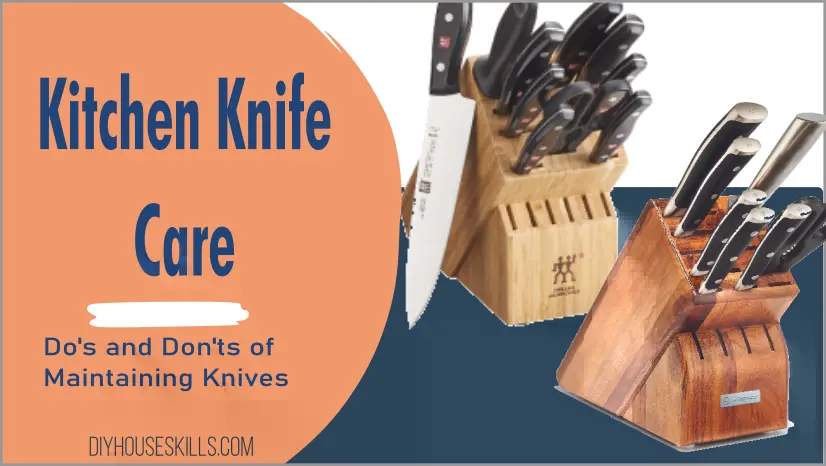
Kitchen knives are one of the most important tools in the kitchen. However, improper care can lead to dull and damaged knives.
In this article, we discuss the do’s and don’ts of kitchen knife care. We cover everything from storing your knives to sharpening them properly.

I’m J.S., I created and am the content manager at DIYHouseSkills.com. I do the research and write the articles that appear on this website. I’ve learned many household skills during my life and think it’s important to at least know the basics so that you can save yourself time and money… READ FULL BIO >
- 5 Tips for Picking Appliances: Conquer the Kitchen (and Beyond!)
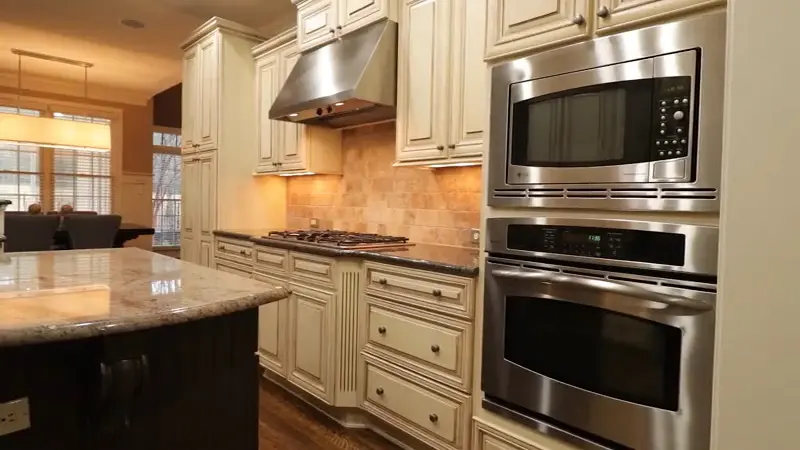 Congratulations, homeowner! You’ve conquered the real estate jungle and landed your dream space. Now comes the fun part (well, mostly fun) – outfitting your new home with functional and stylish appliances! But with so many brands, … Read more
Congratulations, homeowner! You’ve conquered the real estate jungle and landed your dream space. Now comes the fun part (well, mostly fun) – outfitting your new home with functional and stylish appliances! But with so many brands, … Read more - Top 7 Tech Gadgets for a Smart Home
 Upgrade Your Life: Top 7 Tech Gadgets to Transform Your Home into a Smart Oasis Imagine a world where your lights switch on as you walk in, the thermostat adjusts to your perfect temperature before you … Read more
Upgrade Your Life: Top 7 Tech Gadgets to Transform Your Home into a Smart Oasis Imagine a world where your lights switch on as you walk in, the thermostat adjusts to your perfect temperature before you … Read more - What Is Counter-Depth Refrigerator Size
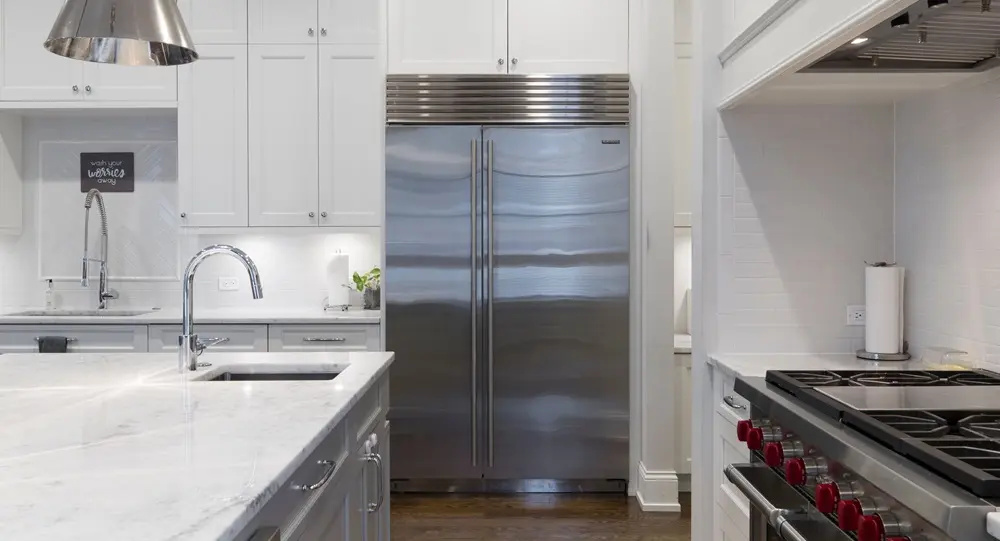 In this guide, we will explore the counter-depth refrigerator size in detail, its benefits and considerations, and tips for integrating one into your kitchen layout. We’ll also provide advice on installation and maintenance, ensuring your counter-depth … Read more
In this guide, we will explore the counter-depth refrigerator size in detail, its benefits and considerations, and tips for integrating one into your kitchen layout. We’ll also provide advice on installation and maintenance, ensuring your counter-depth … Read more - How To Use Bertello Pizza Oven
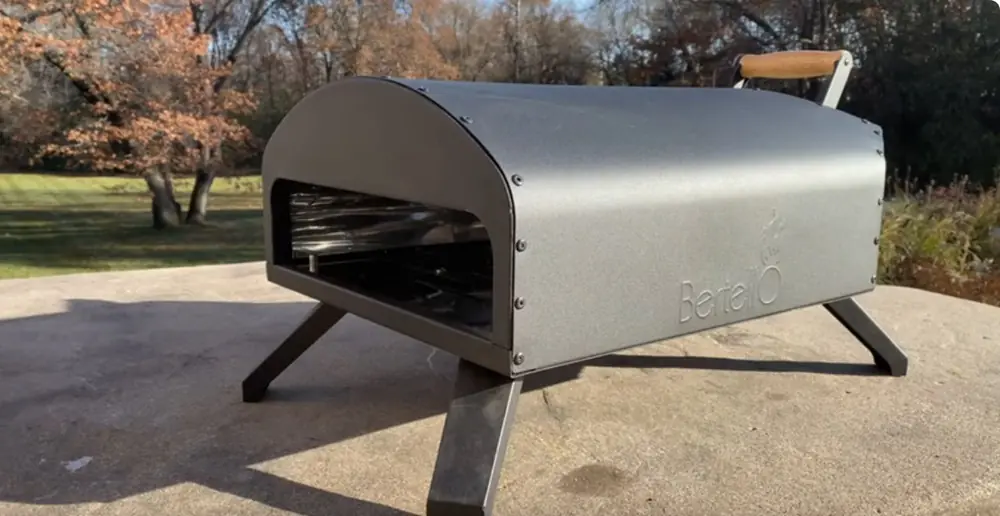 Welcome to my blog. Today, we’re diving into how to use the Bertello pizza oven and the world of homemade pizzas. There’s something truly special about crafting your own pizza from scratch. And with the Bertello … Read more
Welcome to my blog. Today, we’re diving into how to use the Bertello pizza oven and the world of homemade pizzas. There’s something truly special about crafting your own pizza from scratch. And with the Bertello … Read more - How To Adjust Your Cuisinart Mixer: Quick Guide
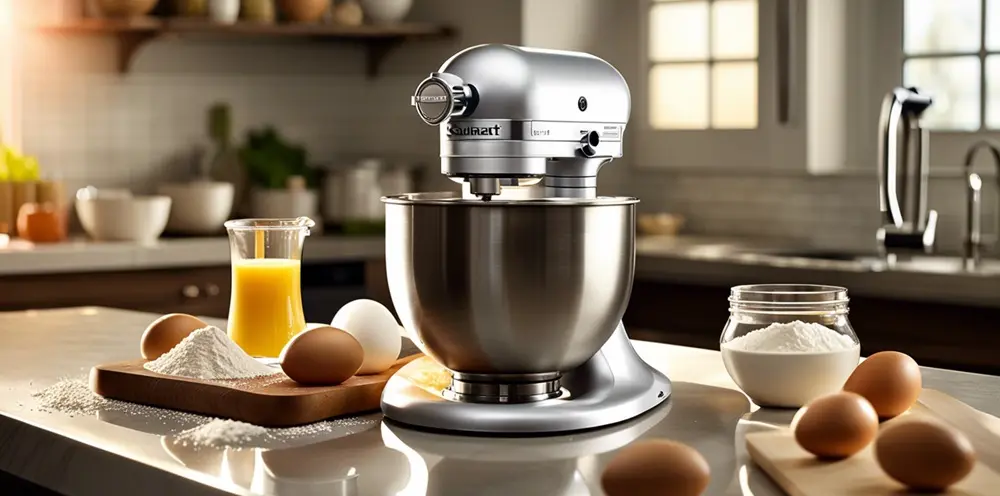 Welcome to the Cuisinart Mixer Adjustment Quick Guide! We will take you through everything you need to know about adjusting your Cuisinart Mixer. Whether you’re a beginner or an experienced baker, this quick guide will help … Read more
Welcome to the Cuisinart Mixer Adjustment Quick Guide! We will take you through everything you need to know about adjusting your Cuisinart Mixer. Whether you’re a beginner or an experienced baker, this quick guide will help … Read more

